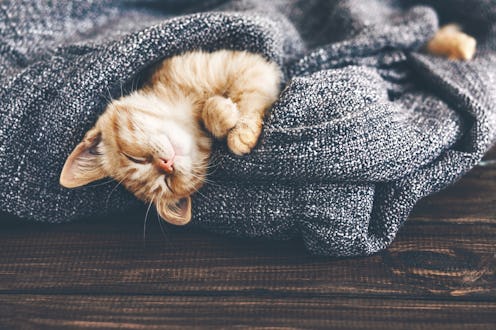While summer is synonymous with beach parties and backyard barbecues, it's also prime time for everything creep crawly. Yes, the bugs are back, and not just the kind that bite you. If you're wondering how to get rid of cat fleas safely, don't fret: there are some tried and true methods to keep your furry friend flea-free. On the other side of the coin, though, there are also a few things you should avoid doing at all costs. Even if your cat is indoor only, it can still get fleas, which is why it's necessary to treat both indoor and outdoor cats.
If you're a new pet parent, you might not know that products approved to treat and prevent fleas on dogs can actually be deadly to cats. This is why it's important to treat your cat and dog with the something that's made to work just for them. Some people learn this the hard way, but the more you know up front, the better your chances of a healthy and happy flea-free summer for pets and humans alike.
"Cats are notoriously sensitive to pyrethroids, a common synthetic ingredient used in flea and tick products. These man-made chemicals are related to the pyrethrins, which are natural products derived from the flower of the chrysanthemum plant," Dr. Jennifer Kvamme wrote for PetMD. "Pyrethroids are typically found in spot-on products made for dogs. They can also be found in sprays meant for treating the home."
This is why it's important to carefully read all labels to make sure products you use in your home don't contain this chemical. If you live in an apartment building that offers in-apartment pest control, ask about the chemicals they're using. If the products do contain pyrethroids, and you still want to go ahead with it, it might be necessary to remove your cat for a few days during and after treatment.
Have both cats and dogs? Obviously, your dog needs a flea preventative too. When you treat your pets, just make sure to keep felines and canines separated for a couple of hours until the solution is absorbed into their skin. If you've been lucky enough to avoid a flea infestation so far, then you might not be aware of some of the signs that your cat has fleas. One of the first things to look for is something called "flea dirt."
This is basically the excrement of fleas, and if your cat has fleas you'll notice flea dirt on kitty's bed and anywhere else kitty lounges around. While fleas will mostly stay on your pet, if the infestations becomes serious you will start to get bites too, generally on your feet and ankles. Don't panic. Even though fleas are annoying, they're unlikely to harm you, and you can get rid of them with a few weeks of treatment and vigilant vacuuming.
If you opt for a flea and tick preventative from your vet, read all of the directions carefully to make sure you're giving your cat the correct dosage for their age and weight. These products are generally applied to the back of kitty's neck and then absorbed into the skin.
"If you have any concerns, or are unsure about which cat tick and flea control products would be best, ask your veterinarian’s advice, even if you are planning to purchase your flea and tick products from a pet store or online supplier," Dr. Kvamme advised.
Want to avoid chemicals completely? There are also some all-natch flea remedies you can try such as apple cider vinegar, aloe vera juice, rosemary, lemon spray, essential oils like lavender and eucalyptus, salt, and diatomaceous earth (seriously, this is the best stuff ever), Mike Clark reported for Cattime. Most of these treatments are applied the same way as flea products you can buy at the store or get from your vet.
Food grade diatomaceous earth is an all-in-one treatment for your pets and your home. It's a fine yet sharp powder that works by suffocating and dehydrating bugs, and a little goes a long way. You can sprinkle it on your cat, around baseboards, doorways, or any other places bugs enter your humble abode. Apartment Therapy recently touted diatomaceous earth as the best way to kill indoor insects, and I agree 100 percent. You can buy it on Amazon, and one bag can last you years.
No matter what type of flea treatment you opt for, make sure to watch your cat closely for a few hours after you apply it. Even if you use a treatment marked safe for cats, just like their human parents, some feline friends are more sensitive to chemicals and oils than others.
What's more, if your cat does get fleas, you'll also want to treat them for tapeworms because cats can acquire tapeworms from accidentally ingesting fleas, according to PetMD. You can buy products to get rid of tapeworms at most pet stores.
Even if you're treating your cat for fleas, it's a good idea to brush kitty regularly with a flea comb to check for fleas and flea dirt. Depending on what part of the country you live in, fleas can be abundant and might turn up even if you've done everything right — take it from someone who's been there more than once. While fleas are definitely a nuisance, this is a classic case of the cliche an once of prevention is worth a pound of cure.
